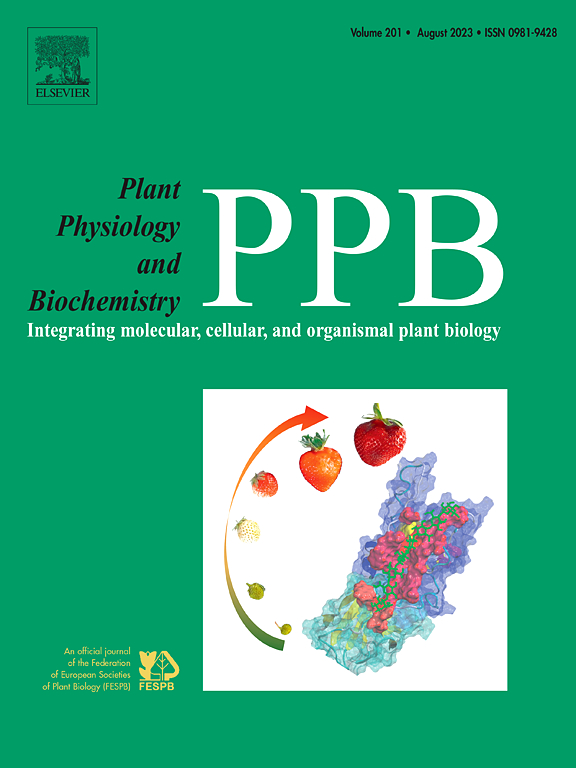水稻根相关微生物群对镉污染的品种特异性响应
IF 5.7
2区 生物学
Q1 PLANT SCIENCES
引用次数: 0
摘要
水稻镉污染严重威胁着全球粮食安全和人类健康。然而,水稻根系相关微生物组对镉污染的响应尚不清楚。本研究利用环境和微生物分析方法,研究了水稻根系相关微生物群与植物金属的相互作用,揭示了根系微生物群调控镉积累的潜在机制。结果表明,2个低Cd积累(LA)品种的籽粒Cd浓度比高Cd积累(HA)品种低34 - 46%,而LA根系中的铁(Fe)含量显著高于HA。根系铁含量与籽粒镉浓度呈极显著负相关(R = - 0.681, p <;0.05)。16S rRNA扩增子测序结果显示,水稻种植在Cd胁迫下显著改变了根系相关细菌群落的多样性,形成了独特的核心内生微生物组(如黄杆菌科和鞘氨单胞菌)。LA品种聚集了更多的根核心微生物类群,促进了铁载体的分泌和根对铁的吸收,从而抑制了水稻对镉的吸收。铬azrol S板检测证实,LA根际中分泌铁载体的微生物比HA根际多1 - 9倍。本研究为了解植物根系相关微生物群对镉积累的影响提供了新的见解,并将有助于制定水稻安全生产的新策略。本文章由计算机程序翻译,如有差异,请以英文原文为准。

Cultivar-specific response of a root-associated microbiome assembly of rice to cadmium pollution
Rice (Oryza sativa L.) cadmium (Cd) contamination is a serious threat to global food security and human health. However, the response of rice root-associated microbiomes to Cd pollution remains unclear. This study investigate the interactions between the root-associated microbiome and plant metals using environmental and microbial analysis methods, to reveal the potential mechanisms of the root microbiomes regulating the Cd accumulation in rice. The results showed that the grain Cd concentrations of the two low-Cd accumulation (LA) cultivars were 34–46 % lower than that of the high-Cd accumulation (HA) cultivars, whereas the iron (Fe) content in the LA roots was significantly higher than that in the HA roots. The root Fe content was significantly negatively correlated with the Cd concentration of grain (R = −0.681, p < 0.05). 16S rRNA amplicon sequencing showed that rice planting significantly changed the diversity of the root-associated bacterial community and formed a unique core endophytic microbiome (such as Xanthobacteraceae and Sphingomonas) under Cd stress. LA cultivars assembled more root core microbial taxa, which promoted siderophore secretion and root Fe uptake, thereby inhibiting Cd uptake by rice. Chrome azurol S plate detection confirmed that the LA rhizosphere was enriched with 1–9-fold more siderophore-secreting microorganisms than the HA rhizosphere. This study provides new insights into the effects of root-associated microbiomes on Cd accumulation in plant and will help develop new strategies for the safe production of rice.
求助全文
通过发布文献求助,成功后即可免费获取论文全文。
去求助
来源期刊
CiteScore
11.10
自引率
3.10%
发文量
410
审稿时长
33 days
期刊介绍:
Plant Physiology and Biochemistry publishes original theoretical, experimental and technical contributions in the various fields of plant physiology (biochemistry, physiology, structure, genetics, plant-microbe interactions, etc.) at diverse levels of integration (molecular, subcellular, cellular, organ, whole plant, environmental). Opinions expressed in the journal are the sole responsibility of the authors and publication does not imply the editors'' agreement.
Manuscripts describing molecular-genetic and/or gene expression data that are not integrated with biochemical analysis and/or actual measurements of plant physiological processes are not suitable for PPB. Also "Omics" studies (transcriptomics, proteomics, metabolomics, etc.) reporting descriptive analysis without an element of functional validation assays, will not be considered. Similarly, applied agronomic or phytochemical studies that generate no new, fundamental insights in plant physiological and/or biochemical processes are not suitable for publication in PPB.
Plant Physiology and Biochemistry publishes several types of articles: Reviews, Papers and Short Papers. Articles for Reviews are either invited by the editor or proposed by the authors for the editor''s prior agreement. Reviews should not exceed 40 typewritten pages and Short Papers no more than approximately 8 typewritten pages. The fundamental character of Plant Physiology and Biochemistry remains that of a journal for original results.

 求助内容:
求助内容: 应助结果提醒方式:
应助结果提醒方式:


